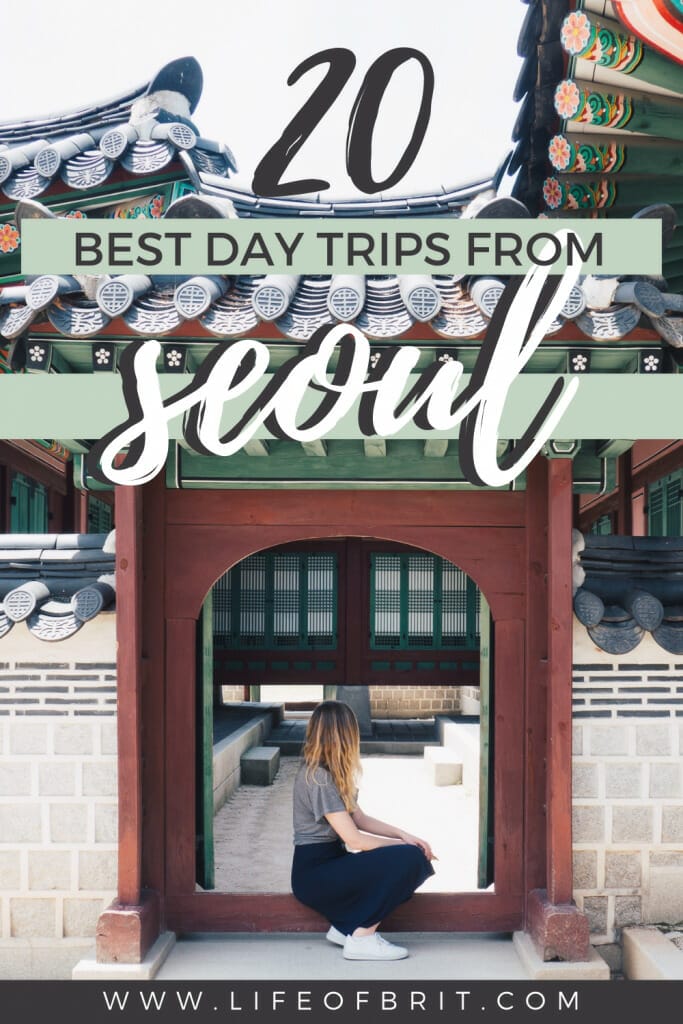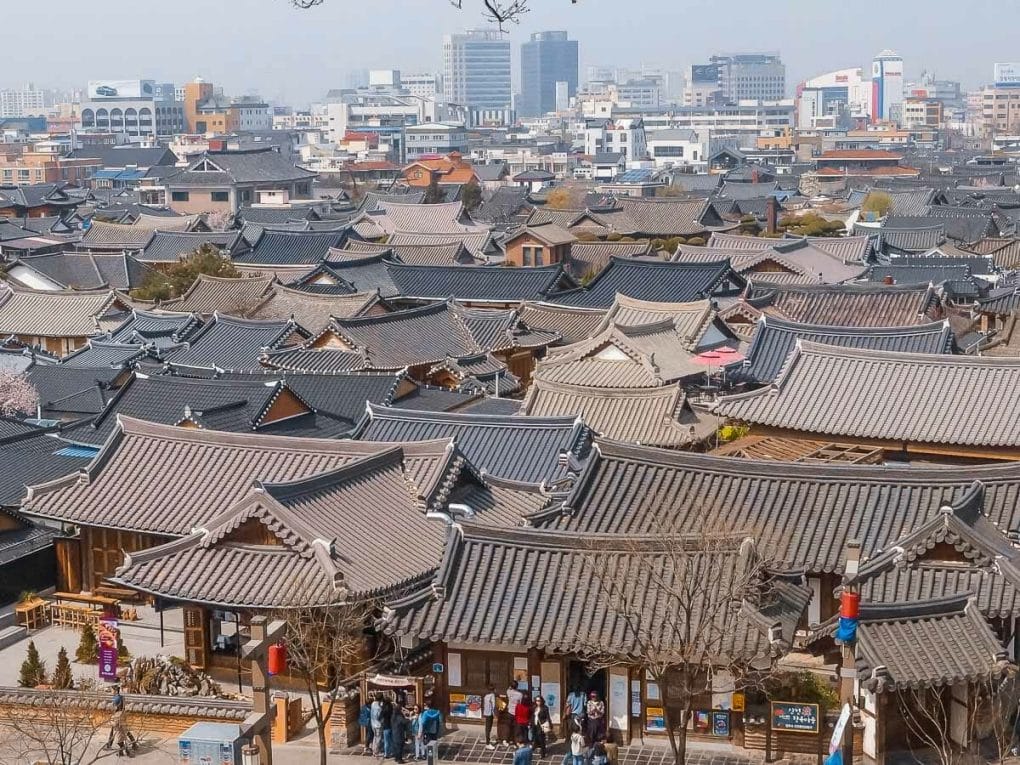Whether you’re visiting Seoul for a few days or are an expat living it up in Korea, these best day trips from Seoul offer so many incredible things to do outside of the city.
Seoul is one of my all-time favorite cities, and it’s a must for anyone planning to travel to Korea! And while there’s no doubt about the never-ending list of amazing and non-touristy things to do in Seoul, you also shouldn’t discount the beautiful sights outside of the city lines.
If you’re looking for some of the best Seoul day trips, this list covers everything from hikes, historical sites, smaller cities, and even some of the most instagrammable places in Korea! Let’s get into it!
Read More: How to Spend 1 Week in South Korea
This post may contain affiliate links, meaning at no additional cost to you, if you click my links and make a purchase, I may earn a small commission. Learn more on my disclosure page. Thank you for your support!
The 20 Best Day Trips from Seoul
Korea’s capital city is beautiful in its own right, but there are some pretty amazing places to see beyond the outskirts of Seoul.
1. Incheon
Incheon is a pretty big city just outside of Seoul and is home to the major international airport that most travelers enter when coming to South Korea. You could easily spend more than a day exploring the best things to do in Incheon, but for a single day, I recommend checking out Chinatown, the Songwoldong Donghwa “Fairy Tale” Village, and the Incheon Fish Market.
How to get to Incheon from Seoul:
It’s super easy to reach Incheon from Seoul via private taxi, train, or bus. Incheon is about 30 miles from Seoul and takes roughly an hour to get there from the city.
The most comfortable way to reach the Incheon Fairy Tale Village is via the 1 subway train line from Yongsan Station in Seoul to Incheon Station.
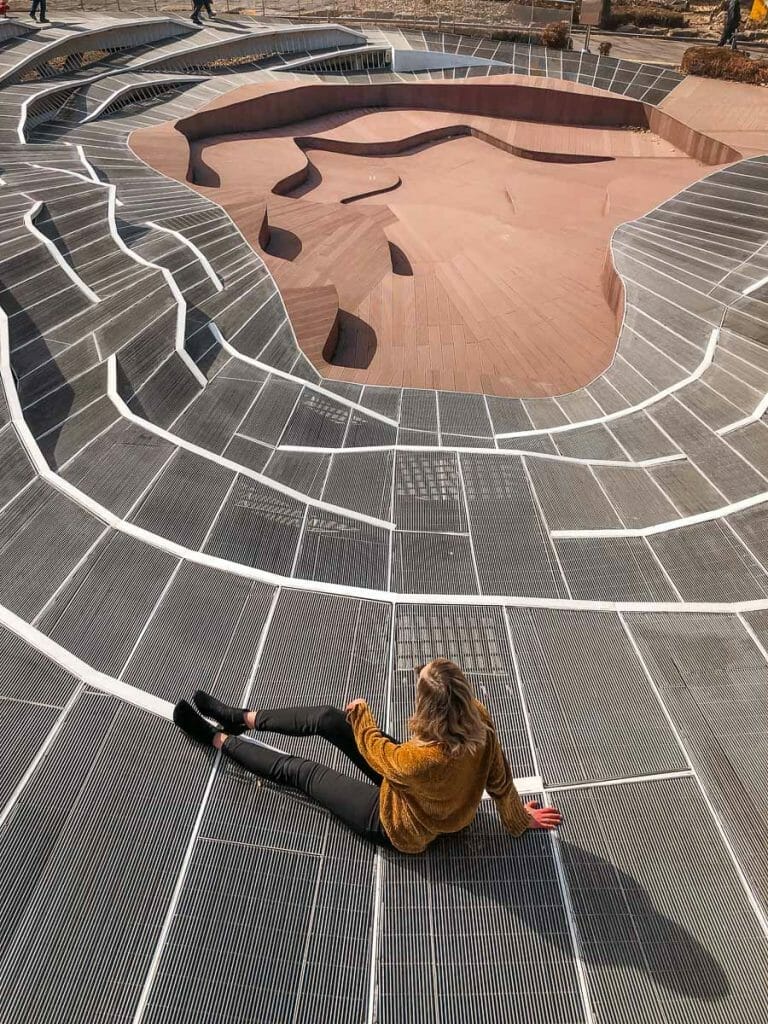
2. Anyang Art Park
Anyang is a small metropolis just outside of Seoul that’s best known for the picturesque Anyang Art Park, a destination filled with impressive pieces of art and a stamp tour you can go on during your visit. The best part – this big park is totally free to enter!
A visit to the Coo Coffee Roasters and the Funique House Museum is worthwhile for those with more time. Samseongsan Mountain is also in Anyang, offering up a few hiking trail options with some pretty nice views.
How to get to Anyang from Seoul:
Address: 경기도 안양시 만안구 예술공원로 131 (석수동) | 131 Yesulgongwon-ro, Manan-gu, Anyang-si, Gyeonggi-do
You can take the Mugunghwa No1223 train from Seoul Station and reach Anyang in about 20 minutes. You’ll need to purchase a ticket from the KTX train station or the KTX website.
It’s also possible to take the blue 1 metro line from Yongsan Station to Anyang or line 4 that can be picked up from Seoul Station and Myeongdong to the Beomgye, Pyeongcheon, and Indeogwon stations in Anyang. A subway ride takes about 35-45 minutes and requires a tap from your Korean T-Money or Cashbee transportation card.
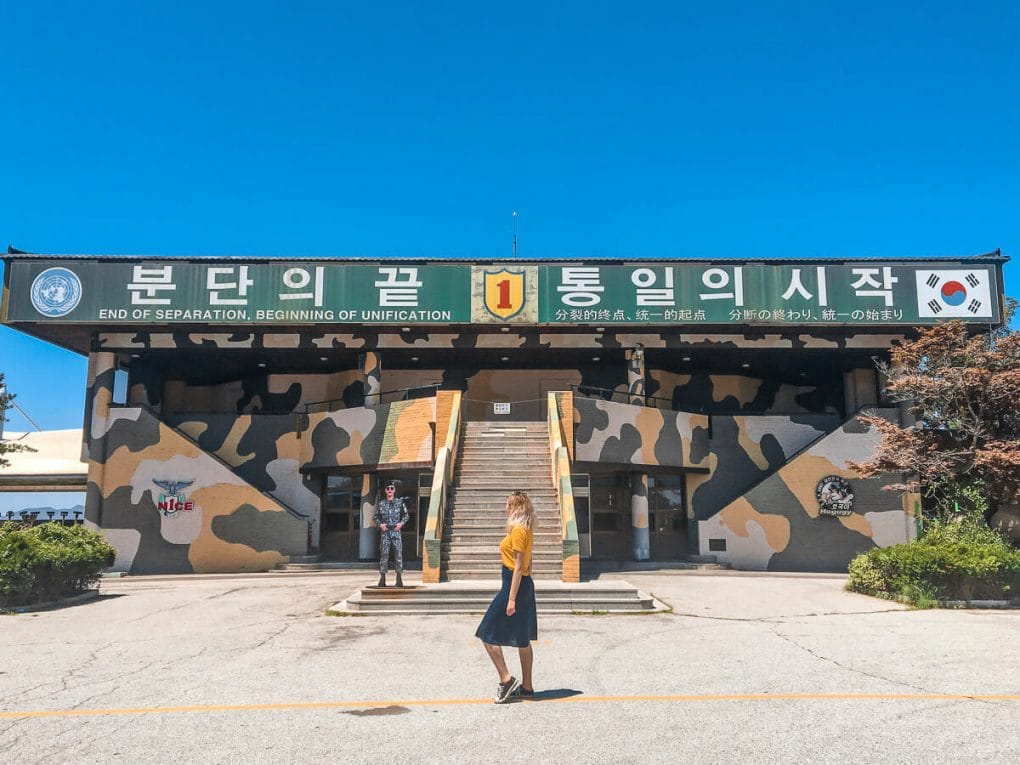
3. The DMZ
The DMZ is the contentious strip of border between North and South Korea that marks where the Korean War came to a standstill back in the 50s, and it makes for an easy and exciting one day trip from Seoul. Today, tourists can learn more about the war and take a peek into the exclusive north.
The top must-sees at the DMZ include the 3rd Infiltration Tunnel, the Dora Observation, Sonjuk Bridge, and the Joint Security Area, where you can see North Korean security guards standing by. There are often closures based on current events between the two countries, so not all attractions may be open.
How to get to the DMZ from Seoul:
To visit the DMZ, you must book an organized tour. Koridoor is one of the best for English-speaking tourists, and you can book a one-day or half-day DMZ tour ranging in price from about $45 – $95. Each tour sees different attractions in the DMZ.

4. Bukhansan National Park
Bukhansan is one of the most exciting hiking day trips from Seoul and is conveniently only about 7 miles north of Seoul. There are numerous trails to choose from, but the most popular is definitely to climb to the Baegundae Peak. From the peak, you can see Seoul on the horizon and enjoy a lunch break on the famous flat top area of the mountain.
The hike is a little less than 5 miles long and takes about 5 or so hours, depending on the crowds (it can get busy). The hike is on the moderate side and does require some challenging rock face climbs. Entrance is free to almost all national parks in Korea, but if you drive, you’ll have to pay for parking, about ₩5,000.
How to get to Bukhansan from Seoul:
The best way to get to Bukhansan is via the orange bus line 704, which you can take from Seoul Station all the way to the Bukhansanseong Fortress Entrance stop (북한산성입구). It’s also possible to take the metro line 3 headed towards Daehwa, get off at Gupabal Station through exit 1, and hop on the 704, 34, or 720 bus from there.
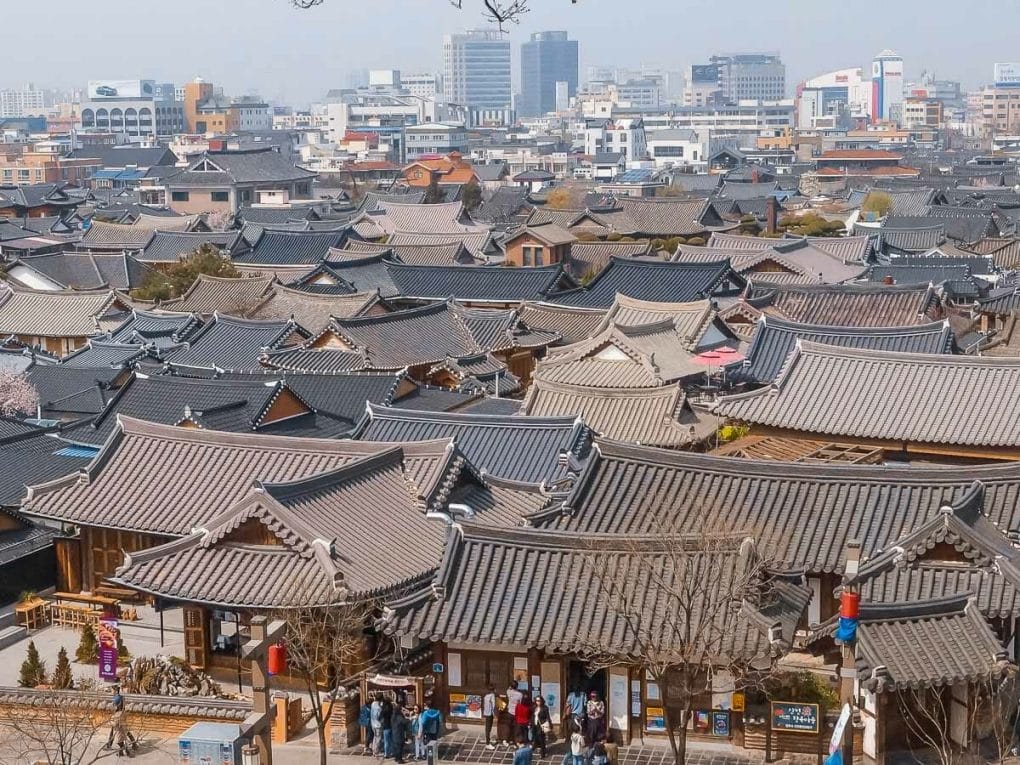
5. Jeonju
Jeonju is a beautiful city home to the famous Jeonju Hanok Heritage Village, where traditional Korean wooden houses are clustered together. Shops, cafes, and restaurants now fill many of the hanoks and make for a fun and cultural day trip.
Other cool things to do in Jeonju include the Gyeonggijeon Shrine, Nambu Market, the Omodae Viewpoint, and the Hanbyeokdang Pavillion. You can also rent a hanbok (traditional Korean garb) during your visit!
Read More: The Best Things to Buy in South Korea
How to get to Jeonju from Seoul:
Jeonju is about 2 hours by car or 3 hours by public transportation from Seoul. You definitely need to have an early start to make a day trip from Seoul work, so I ultimately recommend renting a car if you have an International Driver’s Licence!
Otherwise, you can grab a national bus from the Seoul Central City Bus Terminal to Jeonju and arrive in about 3 hours. A bus ticket will run you about $10+, and can be purchased online.
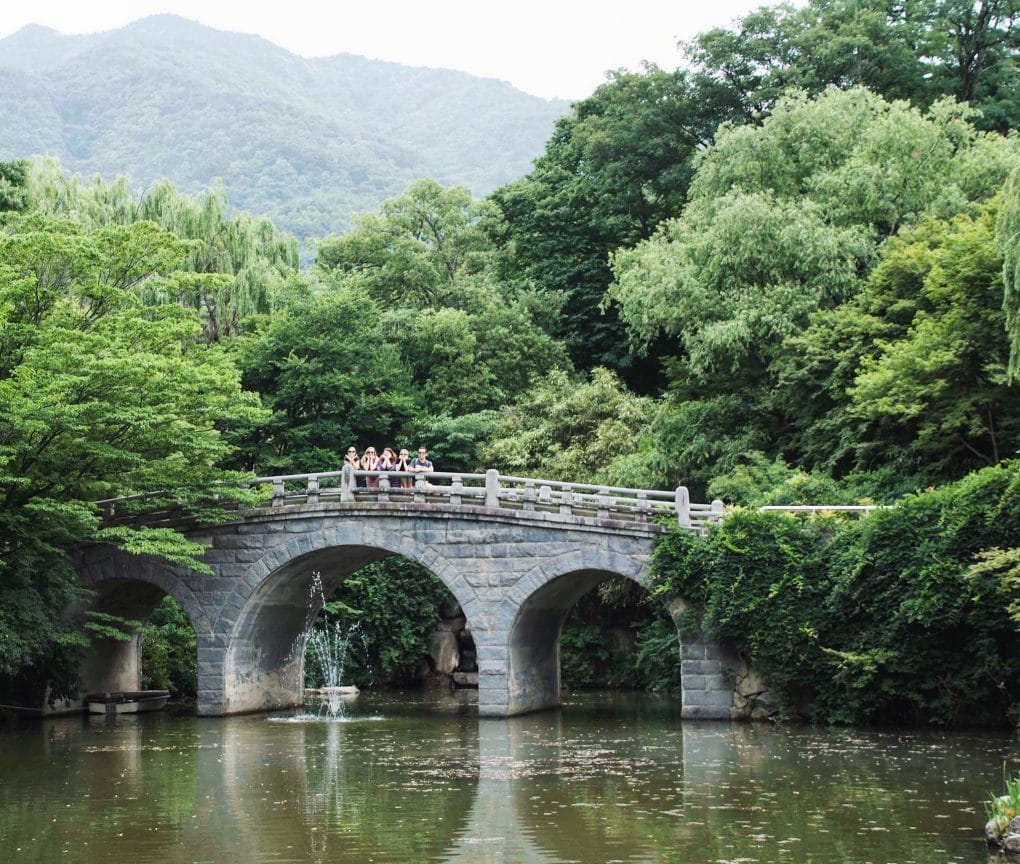
6. Gyeongju
For a historical day tour from Seoul, Korea’s ancient capital and “museum without walls” has a lot to offer visitors. The must-see attractions for a day in Gyeongju include Bulguksa Temple, Donggung Palace, and the Seokguram Grotto. Gyeongju also has a lot of nice cafes and restaurants to enjoy.
Read More: The Best Things to Do in Gyeongju
How to get to Gyeongju from Seoul:
Your best option is to take the 2-hour KTX train from Seoul or Yongsan Station to Singyeongju Station, Gyeongju’s main train terminal. From Singyeongju, you’ll need to take a public bus or taxi about 20 minutes to Gyeongju’s center. The KTX is pricey and ranges from ₩45,000 – ₩55,000.
It’s also possible to take a bus from the Seoul Express Bus Terminal to the Gyeongju Express Bus Terminal, which takes about 3.5 hours and runs about ₩20,000 – ₩25,000. You can book bus tickets online at Kobus or in person at the station.
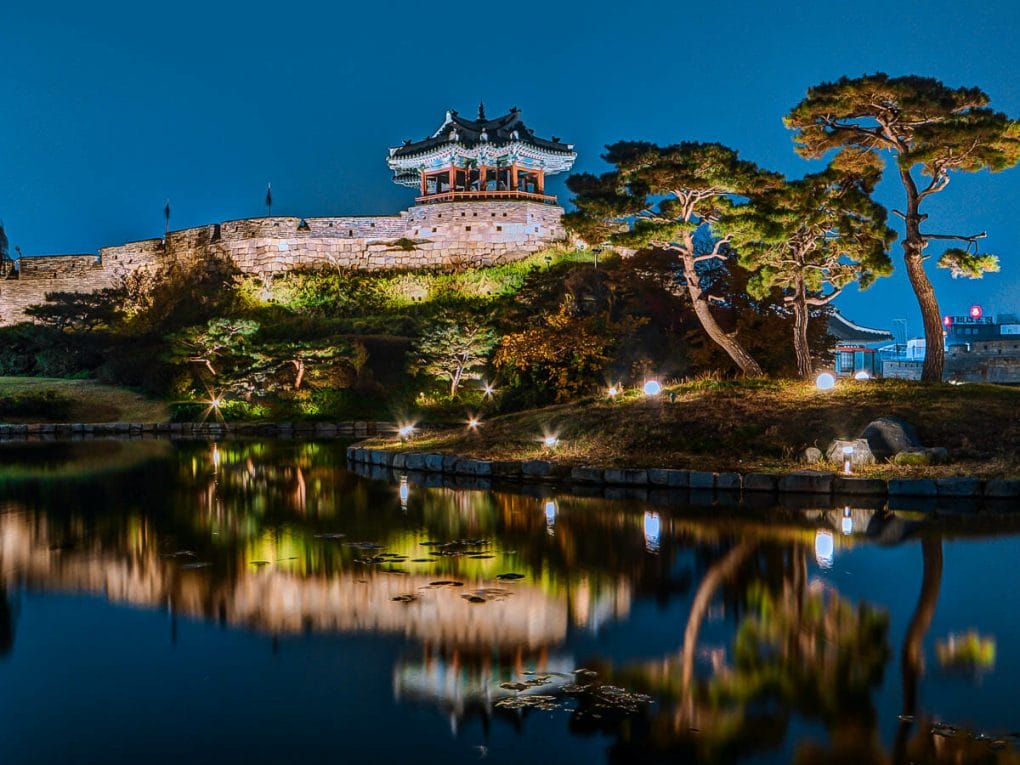
7. Suwon
Suwon is the capital city of the Gyeongju province and lays claim to some incredible ancient landmarks. There’s so much to do that you could probably spend two full days in Suwon, but a day trip is enough time to see the best.
The Suwon Palace, the Paldalmun Gate, and the Samsung Innovation and Hwaseong Museums are some of the top things to do in Suwon. The famous Hwaseong Fortress is also in Suwon and shouldn’t be missed.
How to get to Suwon from Seoul:
Suwon is located about 20 miles from Seoul, and you can take the line 1 subway from Seoul Station (1-hour ride) or the slow Korail train (36 minutes), both arriving at Suwon station. You can also take the fast KTX train (25 minutes) for pretty cheap, only about ₩8,000.
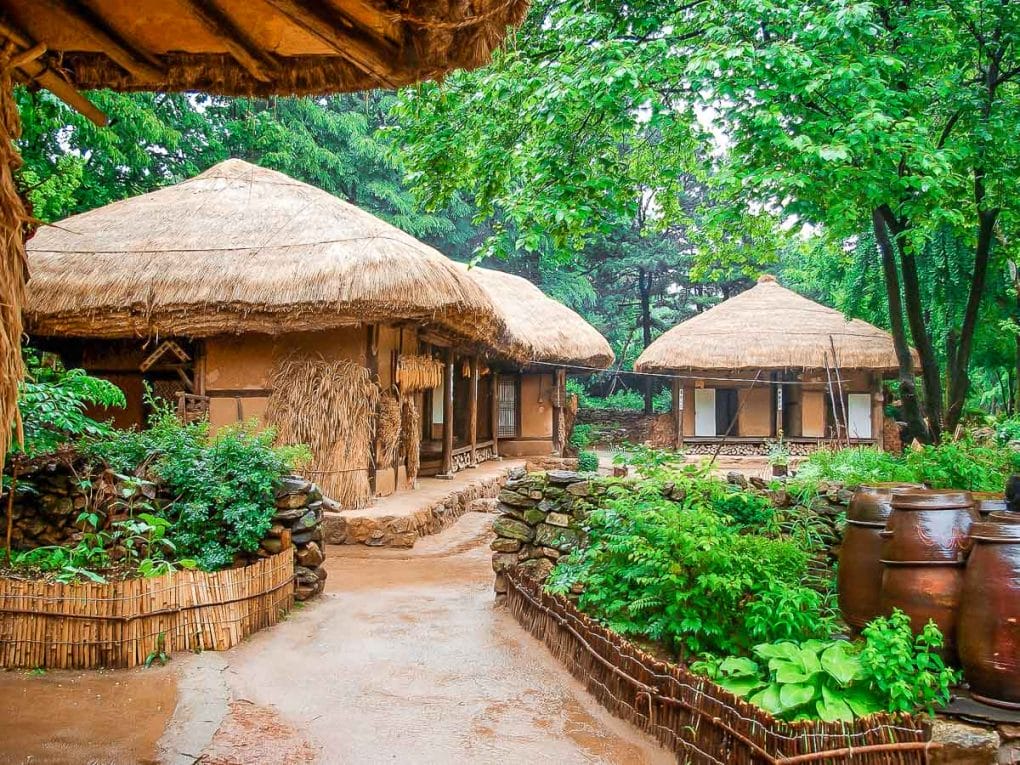
8. Yongin
One of the best things to see in Yongin is the Korean Folk Village, where traditional wooden homes share a glimpse into Korea’s past. Other important cultural landmarks in Yongin are the Wawoojeongsa Temple and the Hoam Art Museum. The city is also known for its waterparks and amusement parks, including the popular Everland, which is deserving of its own day trip from Seoul detailed below!
How to get to Yongin from Seoul:
One of the easiest ways to get to Yongin from Seoul is via bus. Some buses leave from the Seoul Express Bus Terminal or Seoul Station, arriving at the Yongin Bus Terminal. It’s about a 40-minute ride.
You can also opt for the 1.5-hour ride on the Seoul subway from the Wangsimni Station to the Giheung Station or the 30-minute ride between Gangnam and Suji.
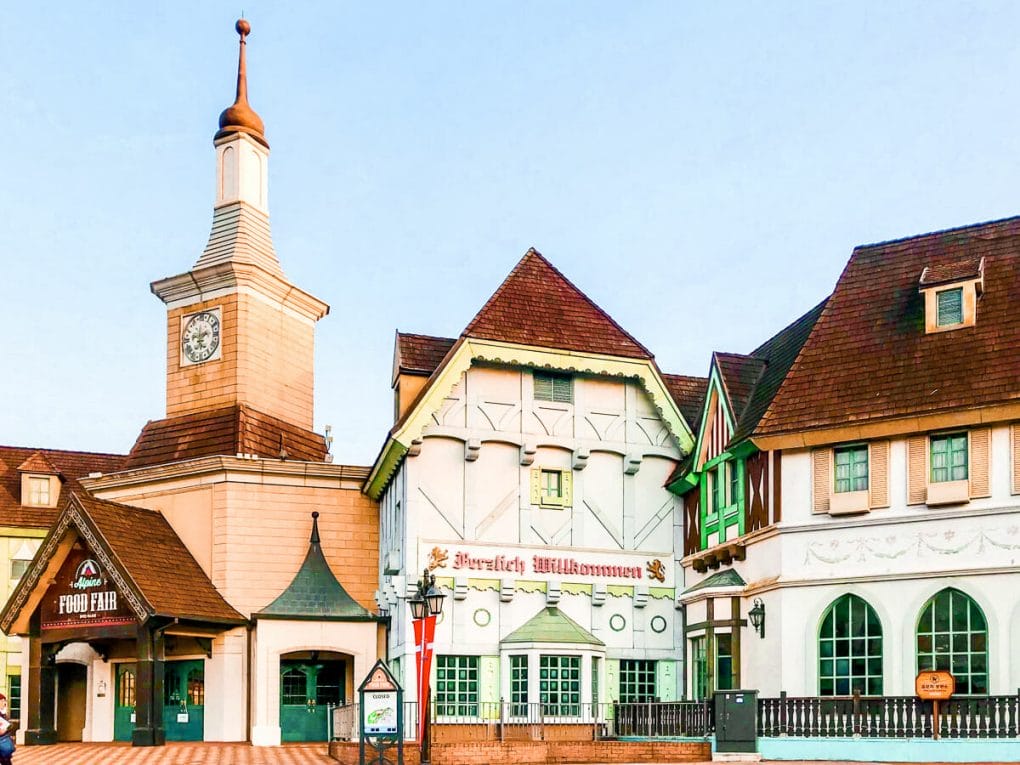
9. Everland Amusement Park
Everland is the most popular amusement park in South Korea and can be found north of Seoul in Yongin. The park is pretty big and features a zoo, the Caribbean Bay waterpark, five roller coasters, and other fun attractions. Tickets are usually about ₩54,000 but can often be purchased at a discounted rate.
How to get to Everland from Seoul:
Address: 경기도 용인시 처인구 포곡읍 에버랜드로 199 (포곡읍) | 199, Everland-ro, Cheoin-gu, Yongin-si, Gyeonggi-do
There are a few convenient options for getting to Everland from Seoul. You can choose to ride the city buses departing from Gangnam Station (bus #5002) or Gangbyeon Station (#5700). The public buses can take an hour or more to arrive in Everland.
There’s also a private shuttle bus you can pay to take that’s a bit quicker but more expensive. The shuttle picks up from outside Hongdae Station, Myeongdong Station, and the Dongdaemun History & Culture Park Station, and more. The private shuttle also takes about an hour.
10. Nami Island
Nami Island is another destination that’s often considered one of the best day trips to Seoul. It’s home to scenic nature surrounded by idyllic waterways and offers some pretty photogenic backdrops. Nami Island is where you can’t find the idyllic pine tree and ginkgo tree lanes. Spring and autumn are popular times to visit to see the cherry blossoms and changing leaves.
How to get to Nami Island from Seoul:
The easiest way to get to Nami Island from Seoul is via a guided tour. Many tours combine Nami island with Petite France and/or Garden of Morning Calm.
For DIY’ers, you can take the national train from Yongsan Station to Gapyeong Station. From Gapyeong, you’ll need to take the local bus 33-5 to reach the Gapyeong Wharf. It’s also possible to take the subway to Gapyeong Station but may require many transfers.
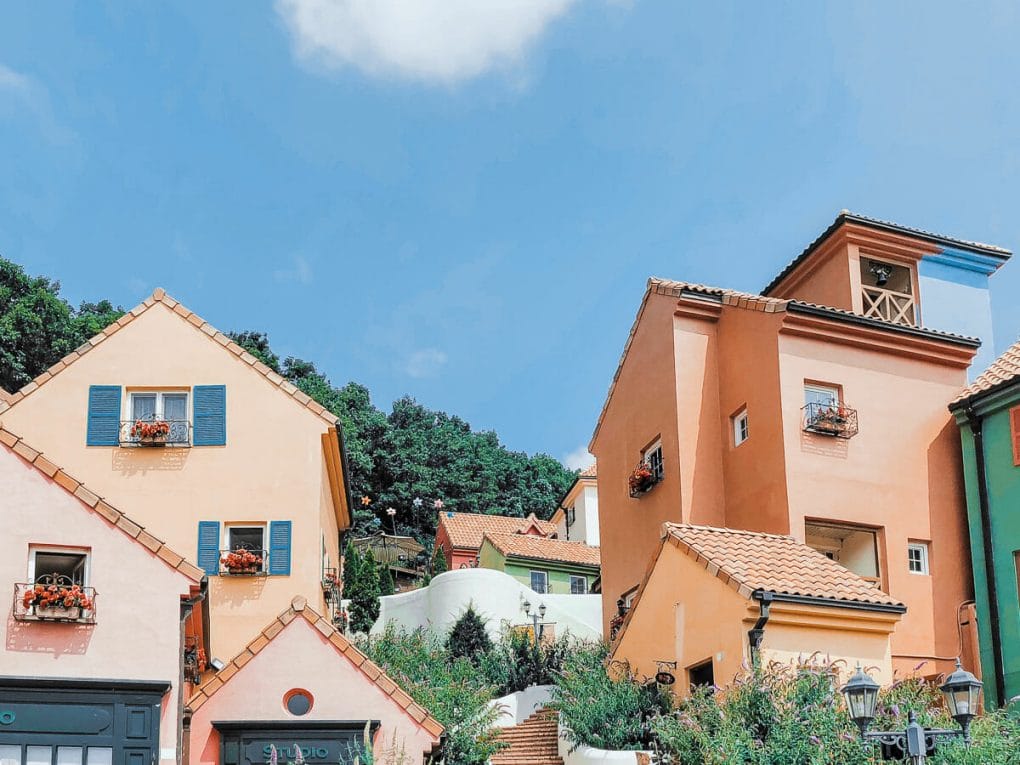
11. Petite France
Petite France is an amusement park in Gapyeong that’s well known as an entertaining Insta spot. The park has blooming gardens and cute colorful buildings and has been featured in numerous K-dramas and K-pop music videos.
The park is open between 9am to 6pm and has an entrance fee of ₩10,000 for adults.
How to get to Petite France from Seoul:
Address: 경기도 가평군 청평면 호반로 1063 | 1063 Hoban‐ro, Cheongpyeong‐myeon, Gapyeong‐gun, Gyeonggi-do
You’ll need to take a train to the Cheongpyeong Station (1.5 hours) and then transfer to the Gapyeong Circle Bus to Petite France. The bus ride is about 30-40 minutes.
Some people choose to skip the inconvenient public transportation route and instead go with an organized tour. Klook and Trazy have options combined with other destinations like Nami Island and The Garden of the Morning Calm.
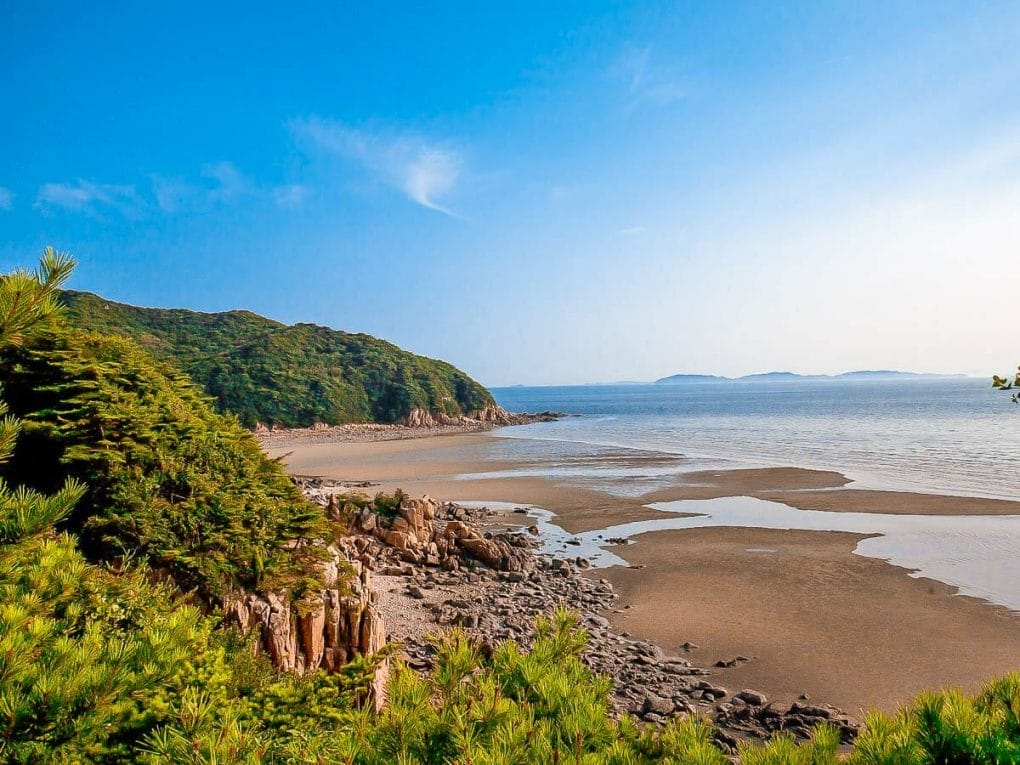
12. Muuido
Muui Island is a small island just south of Incheon and about 75 miles west of Seoul. It’s a hopping beach destination that’s grown in popularity thanks to the recently constructed road connecting the island to the mainland. That means no more slow ferry!
Most people flock to Muuido to spend the day at Hanagae Beach, where charming little beach cabins can be rented out for an overnight stay. Other fun things to do on Muui Island are walking the Marine Tourism Trail and riding the island’s zipline.
How to get to Muuido from Seoul:
Take the subway from Seoul to Incheon’s Unseo station. Outside of exit 2, you’ll need to cross the intersection to get to the bus stop that takes you onward to the beach. The total trip takes nearly 3 hours (1-hour subway, 50-minute bus). Otherwise, it’s a 75-mile drive.
13. Pocheon Art Valley
The Pocheon Art Valley is a scenic park that features unique sculptures, gardens, and a beautiful lake view surrounded by steep cliffs. It was once a quarry that has since been abandoned and transformed into a popular Seoul day trip. Be warned that the park is small and best visited with friends. There are also many stairs to climb or a monorail that can be ridden, and the entrance is ₩5,000.
How to get to the Pocheon Art Valley from Seoul:
Address: 경기도 포천시 신북면 아트밸리로 234 (신북면) | 234, Art valley-ro, Pocheon-si, Gyeonggi-do
The Pocheon Art Valley is about 45 minutes northeast of Seoul, and there are a few public transportation options available. You can take a 70-minute bus from the Dong Seoul Bus Station directly to the Pocheon Bus Terminal.
You can also take the 3 – 38-3 bus from the Uijeongbu subway station, which drops off about a 20-minute walk from the art valley. Or it’s possible to take a Pocheon Art Valley tour which is ultimately the most convenient option, albeit the most expensive.
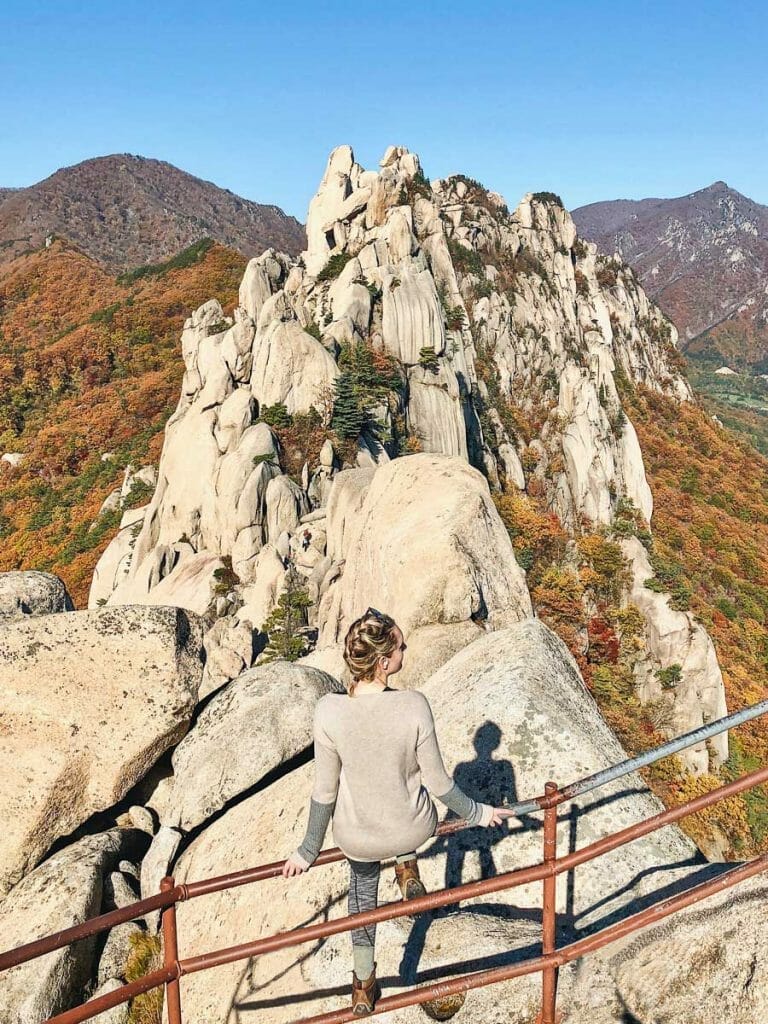
14. Seoraksan National Park
Seoraksan National Park is one of the absolute best hiking spots near Seoul, and if you’re a nature lover like me, I highly recommend taking the time to visit. It’s honestly best as a multi-day trip, but if you’re short on time, it’s possible to take a quick, Seoraksan day trip from Seoul to see the main spots.
I recommend hiking to the peak, seeing the famous Ulsanbawi viewpoint, and climbing up to the Geumganggul Cave, where a Buddhist monk is often found facilitating prayers. The Naksansa Temple is also a must.
Read More: 11 Best Trails for Hiking in Seoul
How to get to Seoraksan from Seoul:
Address: 강원도 속초시 설악동 114-2 | Seoraksan-dong, Sokcho-si, Gangwon-do
Seoraksan is about a 2-hour drive or a 3+ hour bus ride. Otherwise, you’ll need to take a bus from the Dong Seoul bus terminal to the Sokcho Intercity bus terminal. And then from Sokcho, take the 30-minute local bus 7 or 7-1 to the park.\
15. Ansan City
Ansan is an up-and-coming city with industrial vibes and pretty canals. The best things to do in Ansan include taking a stroll in T-Light Park and enjoying skyline views, discussing contemporary art at the Gyeonggi Museum of Art, and smelling the pretty flowers at the Daebu Bada Hyanggi Theme Park. For nature lovers, make time to see the Ansan Botanical Garden and the Ansan Reed and Wetland Park.
How to get to Ansan from Seoul:
To get to Ansan City, hop on Seoul blue metro line 1 to the Sanglogsu subway stop. From here, you’ll need to walk and transfer to a bus that leaves from the Sangnoksu Station bus stop to the Ansan terminal.

16. Namhansanseong Fortress
Namhansanseong is a UNESCO World Heritage site that sits atop Namhansan Mountain. No trip is complete without visiting the four main gates, the south being the largest, most popular, and most accessible, and the ancient walls, palace, and views of the Seoul skyline.
You can easily spend 4-6+ hours hiking around and seeing the sites. The palace costs about ₩2,000 to enter. Otherwise, there aren’t any other admission fees.
How to get to Namhansanseong from Seoul:
Address: 경기도 광주시 남한산성면 남한산성로 731 (남한산성면) | 731, Namhansanseong-ro, Gwangju-si, Gyeonggi-do
The fortress is about 25 km south of Seoul, and you have a few options to get there. First, you can go via the Sanseong Station on line 8. Leave through exit 2 and walk to the bus stop where bus 9, 9-1, or 52 will take you to the Namhansanseong bus stop. The #9 bus is the most frequent and quickest. You can walk to the entrance from here (30 minutes) or take the 11-minute by taxi.
You can also take the 13-2 bus from the Dong Seoul Bus Terminal to the Gangbyeon Station. From there, transfer to a 15-1 bus and get off at the entrance of Namhansanseong.
17. Paju
Paju can be found in the way north close to the North Korean border – so close that you can sometimes hear the North Korean loudspeakers blaring propaganda from the city limits! It’s grown in popularity as a place known for Insta worthy cafes, the Heyri Art Village, Paju Premium Outlets, and the English Village, where many expats teach English in Korea. There are also plenty of things to do, thanks to its close location to the DMZ.
How to get to Paju from Seoul:
If driving, it takes about 1.5 hours to reach Paju from Seoul. Otherwise, you’ll need to go to the Hapjeong Station via metro lines 2 or 6 and leave through exit 1 and look for the bus stop immediately next to the exit. From here, take the 2200 bus and prepare for pretty coastal views on your ride.
You can also take the Trazy private van for a more straightforward journey that’s a little more expensive.
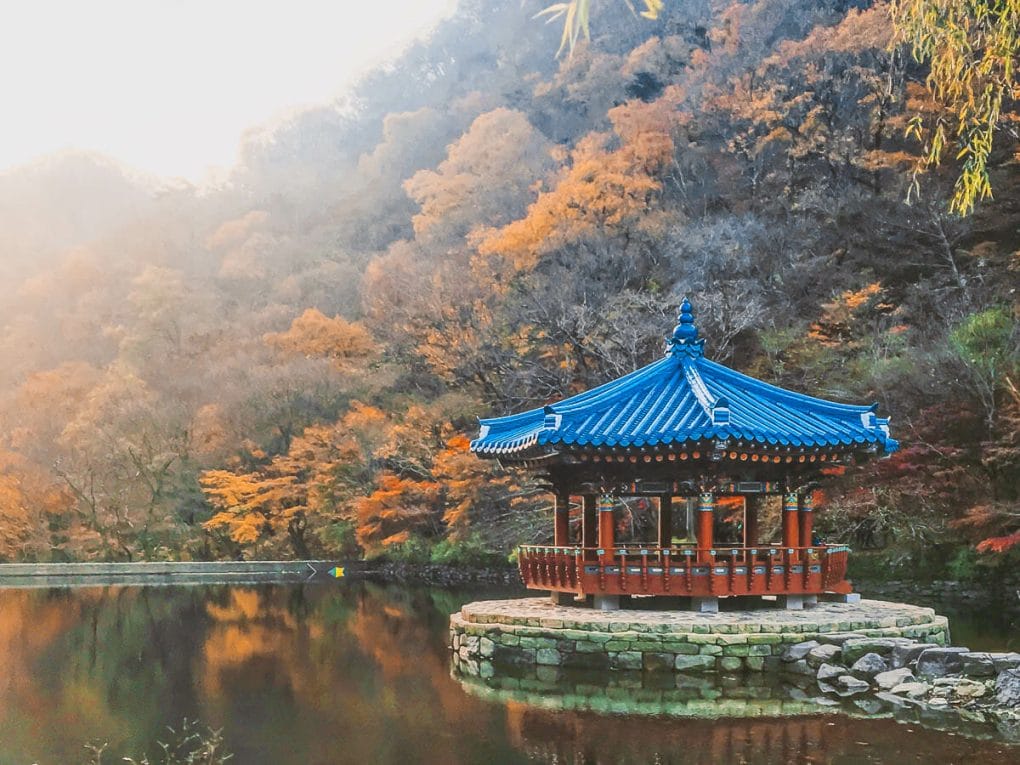
18. Naejangsan National Park
Although a bit far from Seoul, Naejangsan National Park is a popular place to visit to hike and see beautiful fall foliage in the mountains. Other fantastic things to do in Naejangsan include visiting the traditional tea house, temple, and observation deck. If you’re not up to hiking, you can take a cable car to the top!
I recommend spending the night for a more comfy visit, but a day trip from Seoul is possible for those up for an adventure. When we visited, we stayed in a glamping hotel! It costs only ₩3,000 to enter the park! And a fee for parking if driving.
How to get to Naejangsan from Seoul:
Address: 전라북도 정읍시 내장동 내장산로 936 | 936 Naejangsan-ro, Naejang-dong, Jeongeup-si, Jeollabuk-do
The best way to get to Naejangsan on public transportation is by taking the KTX from Yongsan Station (1.5 hours), then walking to the Jeong-Eub-Yeog bus stop, taking bus 171 until the Sinheung-ri stop (40-minute ride). From here you can walk to the entrance of the park.
Or, opt for a classic road trip and rent a car to drive the 260 km, a little less than three hours. You can also take an organized Naejangsan tour with Trazy!
19. The Garden of Morning Calm
The Garden of Morning Calm is a botanical garden north of Seoul that showcases the natural beauty of South Korea. It’s great to visit year-round, putting on varying displays depending on the time of year. The gardens are pretty even in winter, as Christmas decorations and glittering string lights are set up all around.
Many people visit the garden on the same day or on the same tour as Nami Island and/or Petite France.
How to get to the Garden of Morning Calm from Seoul:
Address: 경기도 가평군 상면 수목원로 432 | 432 Sumogwon-ro, Sang-myeon, 상면 Gapyeong-gun, Gyeonggi-do
The Garden is a 2-hour drive by car and about 2.5/3 hours via public transportation. You can get there by taking the subway, bus, or ITX train to the Cheongpyeong Station, and from there, hop on a local bus or taxi to the gardens.
Seeing this popular attraction is honestly best as a Seoul day tour. The Gardens can get super crowded in the peak season, which means long lines waiting for buses back.
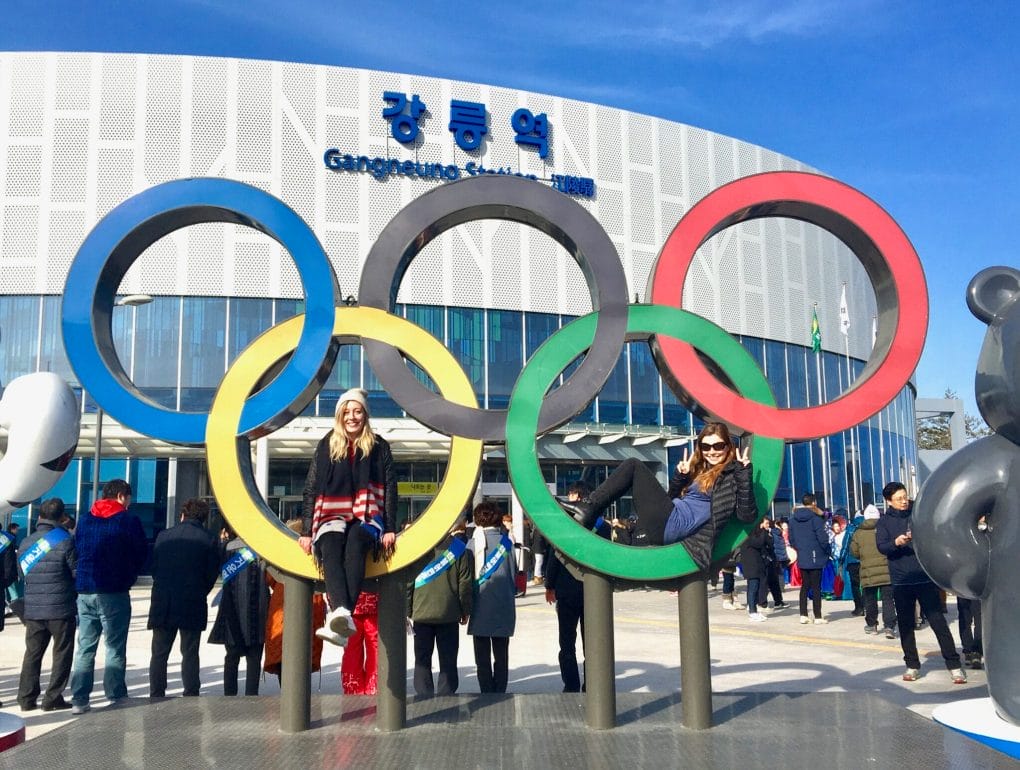
20. Ski Resorts near Seoul
If you’re an avid skier/snowboarder and happen to be in Seoul in the winter, there are numerous great ski resorts to choose from! Some local faves include the Yongpyong Ski Resort, Oak Valley Ski Resort, and High1. You can also venture to PyeongChang for skiing near Seoul, which hosted the 2018 Winter Olympics!
Compared to the US, skiing isn’t that expensive in Korea, and there are usually many equipment rental shops available for those without gear.
Read More: The Best Things to do in Korea in Winter
How to get there:
A tour is probably the best option for convenience and price since packages often include transportation, admission, and gear.
Check out these 1-day tour packages from Seoul to places like Yongpyong Ski Resort (3 hrs from Seoul), High1 (3 hrs from Seoul), and Oak Valley Ski Resort (less than 2 hrs from Seoul).
If you’re not into tours, I recommend renting a car. Ski slopes are usually not easy to get to via public transportation as they’re off in rural areas of the country.
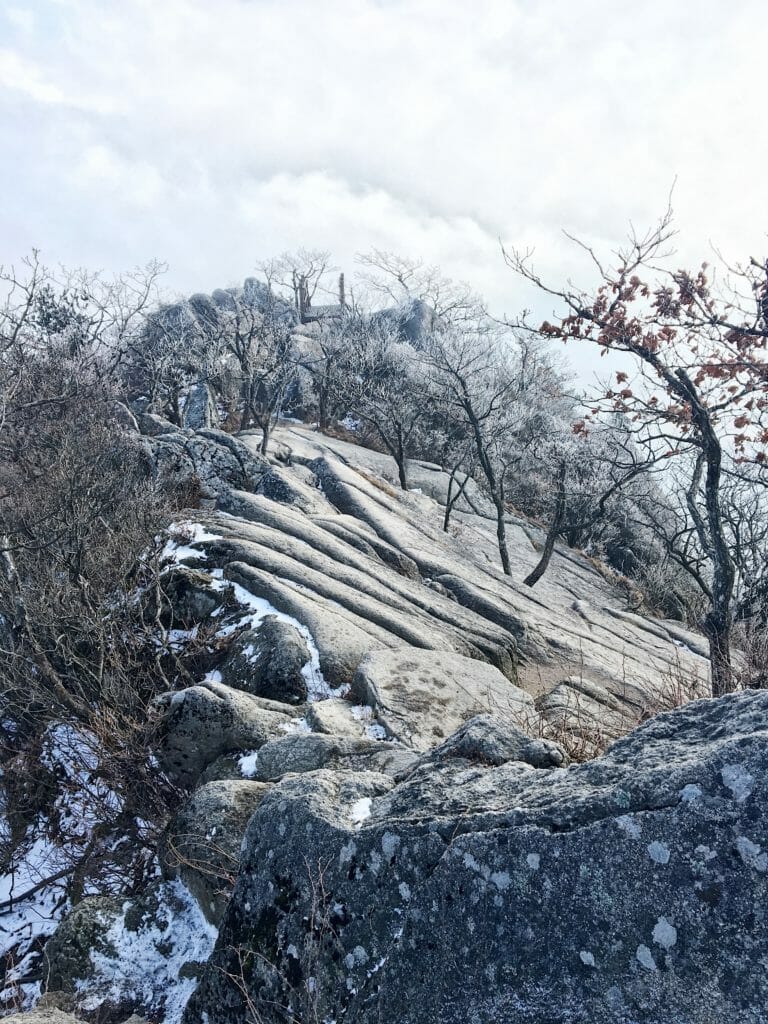
How to Travel from Seoul and Get Around Korea
When planning a Seoul day trip, figuring out the travel is the biggest hurdle. Thankfully South Korea nails it when it comes to public transportation. Here’s what you need to know about getting around Korea.
- Navigation Apps in Korea: Google Maps doesn’t really work in Korea except for mapping out some public transport routes. I recommend downloading the KakaoMaps or Naver Maps apps instead for the most accurate directions – Kakao can be switched to English.
- Renting a car: Renting and driving a car in Korea is actually pretty easy and not overly expensive! You can usually nab a car for about $100 a day, which is nothing if split with friends. Driving in Korea is also relatively easy with traffic signs in English and plenty of navigation apps available. I recommend Lotte for renting cars.
- Taking the national buses: National buses are sometimes the best option and depart from one of Seoul’s three main terminals: Seoul Gyeongbu Express Bus Terminal, Seoul Nambu (South) Bus Terminal, and the Dong Seoul (East) Bus Terminal. You can nab bus tickets at the terminal or websites like Kobus, Bustago, and T-Money. Bus tickets aren’t for a day trip from Seoul often range in price from less than $10-$25.
- Booking bus tickets online: The bus websites aren’t all English friendly, so I recommend using Google Chrome and the Google Translate Extension when researching bus routes. It will translate the entire page decently well (not perfect but manageable)!
- Taking the national trains: Korea has a few train lines that run across the nation at various speeds. Those lines are the KTX (fastest, most expensive), ITX (in the middle), and the Mugunghwa slow train. You can pick up tickets easily online on the English LetsKorail website or at the terminal kiosk machines.
- Taking the metro or city buses: The best way to take the city buses/metro is with a TMoney or Cashbee card. You can pick one up at almost any convenience store for a few bucks, and then you must top them up with cash to pay for trips. To use, you just tap the card when you enter the bus/metro and tap off when you get off. These rides usually start at about ₩1,200 a ride but depend on the distance driven and the city.
There you have it! A comprehensive list of the best day trips from Seoul! Share your questions and comments below 🙂
